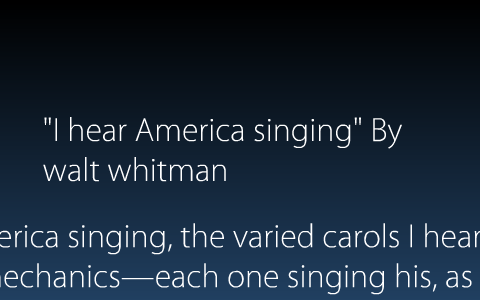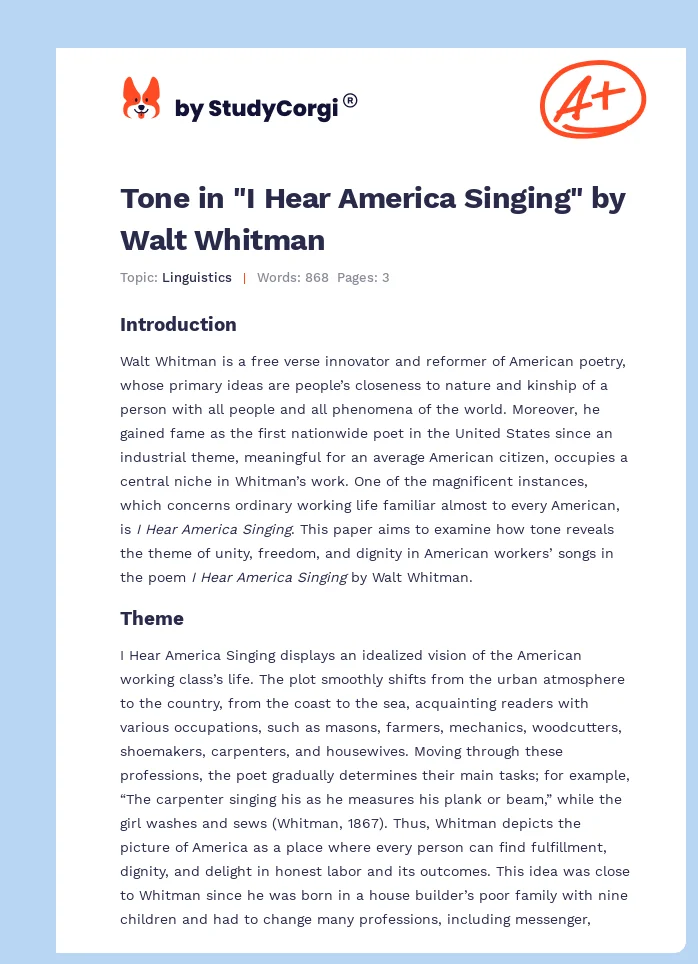“I Hear America Singing” is a poem by the American poet Walt Whitman, first published in the 1860 edition of his book Leaves of Grass. Though the poem was written on the eve of the Civil War, it presents a vision of America as a harmonious community.
Tone in “I Hear America Singing” by Walt Whitman | Free Essay Example
By Walt Whitman. I hear America singing, the varied carols I hear, Those of mechanics, each one singing his as it should be blithe and strong, The carpenter singing his as he measures his plank or beam, The mason singing his as he makes ready for work, or leaves off work, The boatman singing what belongs to him in his boat, the deckhand singing

Source Image: prezi.com
Download Image
i hear america singing by walt whitman. i hear america singing by walt whitman. Best summary PDF, themes, and quotes. More books than SparkNotes. Study Guides; Q & A; … The tone seems stoic and patriotic. “I hear America singing, the varied carols I hear, Those of mechanics, each one singing his as it should be blithe and strong,

Source Image: complex.com
Download Image
Matty Healy slams Malaysia’s anti-LGBTQ laws and kisses bassist onstage in Kuala Lumpur Nov 21, 2023“I Hear America Singing” has a patriotic tone. As the reader interprets the text, the reader gains a sense of pride in the country as Whitman is describing it. Whitman’s choice of professions

Source Image: poemanalysis.com
Download Image
What Is The Tone Of I Hear America Singing
Nov 21, 2023“I Hear America Singing” has a patriotic tone. As the reader interprets the text, the reader gains a sense of pride in the country as Whitman is describing it. Whitman’s choice of professions Summary. In “I Hear America Singing,” the speaker describes various “carols” that arise from different figures in the American working class as people go about their work. He hears the mechanics, the carpenter, the mason, and the boatman singing. The deckhand, shoemaker, hatter, wood-cutter, and ploughboy sing their own songs, as well. The speaker celebrates each individual song, which
I Hear America Singing (Poem + Analysis)
In summary, ‘I Hear America Singing’ sees Whitman celebrating the various ‘carols’ or songs he hears his fellow Americans singing as they go about the work: the mechanics, the carpenter, the mason, the boatman, the deckhand, the shoemaker, the hatter, the wood-cutter, the ploughboy, the mother, the ‘young wife at work’, the seamstress or washerw Walt Whitman I hear America Sing poem 1860 | America sings, Singing, Hearing

Source Image: pinterest.com
Download Image
I Hear America Singing” – MR FANTINI’S CLASS In summary, ‘I Hear America Singing’ sees Whitman celebrating the various ‘carols’ or songs he hears his fellow Americans singing as they go about the work: the mechanics, the carpenter, the mason, the boatman, the deckhand, the shoemaker, the hatter, the wood-cutter, the ploughboy, the mother, the ‘young wife at work’, the seamstress or washerw

Source Image: mrfantinisclass.weebly.com
Download Image
Tone in “I Hear America Singing” by Walt Whitman | Free Essay Example “I Hear America Singing” is a poem by the American poet Walt Whitman, first published in the 1860 edition of his book Leaves of Grass. Though the poem was written on the eve of the Civil War, it presents a vision of America as a harmonious community.

Source Image: studycorgi.com
Download Image
Matty Healy slams Malaysia’s anti-LGBTQ laws and kisses bassist onstage in Kuala Lumpur i hear america singing by walt whitman. i hear america singing by walt whitman. Best summary PDF, themes, and quotes. More books than SparkNotes. Study Guides; Q & A; … The tone seems stoic and patriotic. “I hear America singing, the varied carols I hear, Those of mechanics, each one singing his as it should be blithe and strong,

Source Image: nbcnews.com
Download Image
Grammys 2020 were all about Billie Eilish, a singer who represents a new era for female artists Anaphora. As we have already mentioned, anaphora is employed at the beginning of some lines of the poem: “The carpenter singing his as he measures his plank or beam, The mason singing his as he makes ready for work, or leaves off work, The boatman singing what belongs to him in his boat, the deckhand. singing on the steamboat deck,” (ll. 3-6)

Source Image: nbcnews.com
Download Image
She sang the iconic ‘Reading Rainbow’ theme. Decades later, her voice is going viral on TikTok. Nov 21, 2023“I Hear America Singing” has a patriotic tone. As the reader interprets the text, the reader gains a sense of pride in the country as Whitman is describing it. Whitman’s choice of professions

Source Image: nbcnews.com
Download Image
I HEAR AMERICA SINGING – WALT WHITMAN| Poem analysis| American Poetry – YouTube Summary. In “I Hear America Singing,” the speaker describes various “carols” that arise from different figures in the American working class as people go about their work. He hears the mechanics, the carpenter, the mason, and the boatman singing. The deckhand, shoemaker, hatter, wood-cutter, and ploughboy sing their own songs, as well. The speaker celebrates each individual song, which

Source Image: m.youtube.com
Download Image
I Hear America Singing” – MR FANTINI’S CLASS
I HEAR AMERICA SINGING – WALT WHITMAN| Poem analysis| American Poetry – YouTube By Walt Whitman. I hear America singing, the varied carols I hear, Those of mechanics, each one singing his as it should be blithe and strong, The carpenter singing his as he measures his plank or beam, The mason singing his as he makes ready for work, or leaves off work, The boatman singing what belongs to him in his boat, the deckhand singing
Matty Healy slams Malaysia’s anti-LGBTQ laws and kisses bassist onstage in Kuala Lumpur She sang the iconic ‘Reading Rainbow’ theme. Decades later, her voice is going viral on TikTok. Anaphora. As we have already mentioned, anaphora is employed at the beginning of some lines of the poem: “The carpenter singing his as he measures his plank or beam, The mason singing his as he makes ready for work, or leaves off work, The boatman singing what belongs to him in his boat, the deckhand. singing on the steamboat deck,” (ll. 3-6)